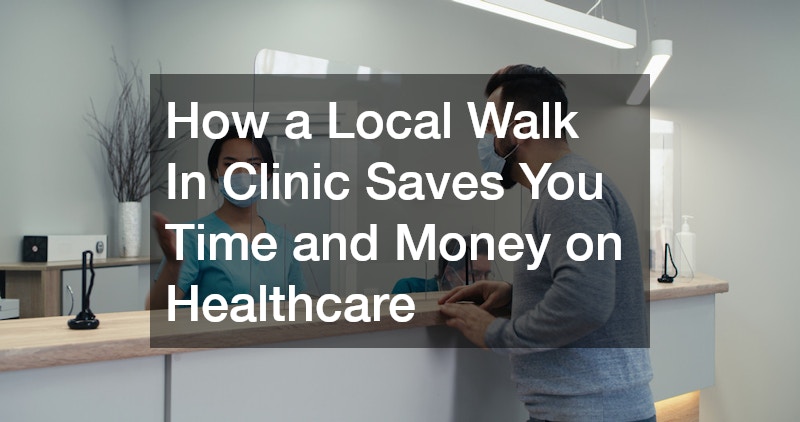Explore how local walk in clinic can be a cost-effective and time-saving alternative to traditional healthcare settings. In a world where healthcare accessibility and affordability are pivotal concerns, walk-in clinics present a practical solution. These clinics offer a model of convenience and efficiency that aligns with the fast-paced lifestyle of modern society.
Common Medical Treatments
Walk-in clinics provide care for a variety of common medical issues, such as minor injuries, infections, and colds. Unlike emergency rooms, they cater to non-life-threatening conditions, allowing for a streamlined medical intervention. This specialization in treating common ailments without an appointment enhances the accessibility of healthcare for patients.
These clinics often employ skilled professionals capable of addressing a diverse range of minor health issues. By offering immediate attention and treatment, they reduce the necessity for lengthy hospital visits. Their ability to handle such conditions promptly is a cornerstone to efficient healthcare delivery.
Preventive Care Options
Preventive services at a local walk in clinic include vaccinations and routine health check-ups, offering an easy option for maintaining health. Regular screenings and immunizations are accessible without the need for prior appointments. This accessibility to preventive care is crucial for managing chronic diseases and avoiding more significant health problems.
Patients benefit from the convenience of getting vaccinated or screened during a brief visit, which fits into their busy schedules. These clinics contribute to public health by facilitating disease prevention and promoting healthier communities. By serving as access points for crucial health interventions, they complement the broader healthcare infrastructure.
Preventive measures taken at walk-in clinics can effectively reduce healthcare costs in the long term. Empowering individuals to manage their health proactively leads to decreased hospital admissions and treatment expenses for chronic conditions. Therefore, the role of walk-in clinics in public health is both essential and impactful.
Diagnostic Services
Walk-in clinics often provide an array of diagnostic services, including X-rays, blood tests, and other necessary screenings. These services are crucial for the early detection of health concerns, allowing for timely medical intervention. Their ability to perform these diagnostics quickly sets them apart as a valuable healthcare resource.
Access to in-house diagnostic tools means that patients receive comprehensive evaluations without the need to visit multiple facilities. This approach emphasizes convenience while maintaining quality care standards. By streamlining the diagnostic process, walk-in clinics contribute to faster treatment plans and resolutions for patients.
No Appointment Necessary
One of the primary time-saving benefits of walk-in clinics is the elimination of the need for appointments. Patients can simply walk in and receive medical attention without waiting for days or weeks. This flexibility is particularly advantageous for individuals with unpredictable schedules or urgent non-emergency needs.
By removing the appointment requirement, walk-in clinics offer a hassle-free healthcare experience. The ability to receive medical care on a walk-in basis aligns with the demands of today’s fast-paced lifestyle. This model enables patients to prioritize their health without compromising their personal or professional commitments.
Shorter Wait Times
Walk-in clinics typically offer significantly shorter wait times compared to emergency rooms and general practitioners. Patients can often be seen within minutes of arriving, which contrasts starkly with the lengthy delays common in traditional settings. This efficiency makes walk-in clinics an appealing option for those seeking immediate attention for minor health concerns.
This reduction in waiting time is achieved through the focused nature of walk-in clinics, which primarily treat non-life-threatening conditions. This specialization allows for a streamlined flow of patients and rapid turnover. As a result, patients can efficiently receive care without the frustration of extended delays.
Convenient Locations and Hours
Walk-in clinics are strategically located to maximize accessibility, often situated in easily reachable areas like shopping centers and community hubs. These locations make it simple for individuals to combine healthcare visits with other daily activities. This strategic positioning enhances the clinic’s appeal as a convenient option for busy patients.
In addition to central locations, walk-in clinics frequently offer extended hours that accommodate various schedules. Evening and weekend openings provide patients with the flexibility to seek care outside traditional working hours. This flexibility ensures that healthcare is accessible to a wider demographic, accommodating different lifestyles and needs.
Insurance and Payment Options
Walk-in clinics typically accept a range of insurance plans, making healthcare more accessible to insured patients. Their flexible payment options ensure that even those without insurance can afford necessary medical care. Such inclusivity helps bridge the gap in healthcare accessibility for uninsured individuals.
In conclusion, local walk-in clinics present a compelling model of healthcare delivery that emphasizes both time and cost savings. The services they offer cater to minor ailments, preventive care, and essential diagnostics, providing comprehensive care without the need for prior appointments. Their strategic locations, shorter wait times, and flexible payment options make them an integral part of the healthcare ecosystem. By reducing both financial and temporal barriers to healthcare, walk-in clinics enhance accessibility and efficiency, ensuring that patients receive timely, affordable care. As the demand for accessible healthcare continues to grow, the role of walk-in clinics within the medical landscape remains invaluable.





